The Descent of Man
Darwin had been criticized for barely referring to humans in the Origin of Species. He rectified this in his two volume work, The Descent of Man and Selection in Relation to Sex (1871). His prevailing argument, occupying almost half of the book, was that vertebrates (animals with backbones) had descended from a marine ascidian (a sea squirt), and that humans had later evolved from an “ape-like progenitor.”
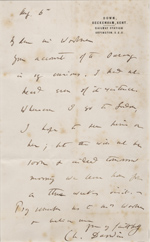 |
Photograph of Charles Darwin (1809-1882) with letter written to sculptor and poet Thomas Woolner (1825-1892). [zoom] The letter, dated August 6, was written in 1878. My dear Mr Woolner
Your account of the Ourang is very curious. I had not heard even of its existence. Whenever I go to London, I hope to see him or her; but this will not be soon & indeed tomorrow morning we leave home for a three weeks visit.—— Please remember us to Mrs Woolner . . . Yours very faithfully Ch. Darwin Courtesy of Stephan Loewentheil and The 19th Century Shop, Baltimore, Maryland. |
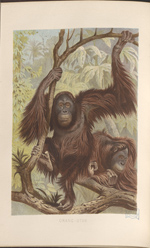 |
Alfred Edmund Brehm. Brehms Thierleben. Allgemeine Kunde des Thierreichs. Leipzig: Bibliographisches Institut, 1882-84. [zoom] Over a period of years, Darwin observed orangutans in the Zoological Gardens, Regent’s Park, in London. He relied on Alfred Edmund Brehm’s illustrations from an earlier edition of his multi-volume work, and used some of the engravings in Descent of Man. |
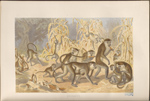 |
Alfred Edmund Brehm. Brehms Thierleben. Allgemeine Kunde des Thierreichs. Leipzig: Bibliographisches Institut, 1882-84. Vol. 1. [zoom] This troop of green, or vervet, monkeys (Cercopithecus sabaeus, synonym Chlorocebus aethiops) illustrate Darwin’s discussion of social animals. He argued that the development of morality originated in animals that relied on one another and lived in groups. |
 |
Thomas Henry Huxley. Evidence as to man’s place in nature. London: Williams and Norgate, 1863. First edition. [zoom] Darwin often referred to Huxley’s comparison of primate skeletal structure in Descent of Man. When Darwin first read Huxley’s book, he wrote to the author: “I declare I never in my life read anything grander.” |
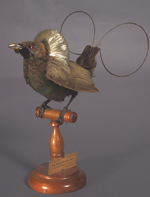 |
Magnificent Paradise Bird. (Diphyllodes magnificus). [zoom] On loan from Cornell University Museum of Vertebrates. |
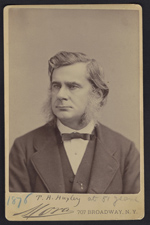 |
Cabinet card photograph of Thomas Henry Huxley (1825-1895). [zoom] The zoologist Thomas Henry Huxley was a good friend of Darwin’s. Known famously as “Darwin’s bulldog,” he was an outspoken defender of his ideas. |
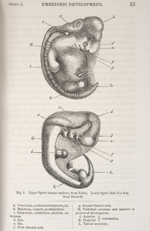 |
Charles Darwin. The Descent of Man, and Selection in Relation to Sex. London: J. Murray, 1871. First edition. [zoom] Darwin compared a human embryo (above) to that of a dog (below), providing one of the first visual comparisons of these forms to Victorian readers. |
 |
Henrietta Emma Darwin (1843-1929).
Darwin’s daughter “Etty” became his valued editor. After the publication of Descent, he wrote to her: “Several reviewers speak of the lucid, vigorous style, &c. Now I know how much I owe to you in this respect, which includes arrangement, not to mention still more important aids in the reasoning.” Like most female Victorian assistants, her help was not acknowledged, and hence invisible to readers. Original held by the Cambridge University Library. |